WASHINGTON—I have now spent roughly twice as many hours standing on the sidewalk outside Bad Saint as I have spent inside eating its extraordinary Filipino food.
This is not an ideal ratio, but at least I had company. Bad Saint, in this city’s Columbia Heights neighborhood, has never taken reservations since it began operating in 2015.
The line that begins forming on 11th Street at least two hours before the doors open at 5:30 p.m. is by now as much a part of the experience of having dinner at Bad Saint as hanging out in the stadium parking lot is a part of the experience of seeing a Phish concert.
Repeat customers are common and easy to spot. They’re the ones who have brought folding chairs, bottles of water, boxes of wine, volumes of Murakami and Ferrante, and bug spray to keep away the mosquitoes who also like dining at Bad Saint.
Just 24 seats
I felt relief and joy each time the four bamboo blinds would be raised in unison at 5:30 p.m. by four servers, one of whom would then unlock the door and start filling the 24 seats.
Genevieve Villamora, the partner who most often handles this task, has compared it to a game of Tetris. The largest tables hold just four people, as some parties of five or six have learned to their regret.
All the other seats are jimmied into blind alleys and passageways around the open kitchen. Once they are all taken, Villamora takes names and numbers for openings later in the night.
With a woven Filipino mat on the wall and light filtering down from geometric slashes in a ceiling of oxidized-steel tiles, the restaurant has a certain compulsory intimacy.
Clearly, Bad Saint was built to make the best of its scarce square footage, not to handle the pressure of being one of Washington’s most sought-after restaurants.
Now it has to do both, because the food that Tom Cunanan and his cooks prepare under columns of wok smoke is richly compelling no matter how many prior run-ins you’ve had with Filipino food.
Adobo of tender squid
Most people with a glancing knowledge of the cuisine have tried an adobo, a garlic-laden stew braised in soy sauce that’s been soured with vinegar.
But Bad Saint’s adobo of tender squid is still astonishing, its sauce deepened and darkened by squid ink and given a slow, lingering burn by long peppers.
The oxtails and bok choi stewed in peanut sauce with an intense undercurrent of shrimp and anchovies is amazing whether this is your first encounter with kare-kare or your hundredth.
I love bitter melon, but even the skeptics I’d brought with me were won over by Bad Saint’s stir-fry, in which the vegetable’s aggressive tendencies are offset by fermented black beans, softened by eggs and sweetened by a topcoat of fried shallots.
Startlingly good
My guests were even more dubious about pancit canton, a Filipino lo mein that can be reassuringly bland. As interpreted by Cunanan, with lots of royal trumpet mushrooms and a steady thrum of Calabrian chiles, it is startlingly good.
Villamora and her partner in the restaurant, Nick Pimentel, have Filipino heritage but were born and raised in the United States. (The restaurant’s name is derived from St. Malo, Louisiana, the first Filipino settlement in this country.)
Cunanan was born in the Philippines and has called his mother his main inspiration in the kitchen.
Some of the cooking has a homey simplicity, like the arroz caldo, chicken in a ginger-laced rice porridge that can be cranked up with a dab of red chile paste or left to its own, soothing charms.
Luxuriously flavorful laing
In other dishes, Cunanan stretches tradition to wrap it around local ingredients.
In the Philippines, laing would be made by stewing dried taro leaves in coconut milk. At Bad Saint, the leaves are kale, braised to a velvety tenderness and swaddled in Chesapeake crab meat.
This laing is so luxuriously flavorful, I can’t get it out of my head, and I don’t want to.
If you don’t get into the first seating, you might spend the cocktail hour checking the screen on your phone while you wait a few doors down at Room 11, also owned in part by Pimentel.
Once you gain entry, you can have one of the Filipino-influenced mixed drinks like the Chili Manilli (spicier than I wanted with this food) or a home-brewed green mango soda (lovely).
Wine selection
Bad Saint carried about three wines when it opened. Now the selection is almost long enough to be called a list, and is wisely centered on lively, aromatic bottles like a red grenache from Tarragona or a still white from Catalonia that is a blend of xarello and riesling.
The beers are even more esoteric and reflect this restaurant’s easy assurance that people come here to be turned on to something new.
I especially admire Bad Saint’s refusal to translate Filipino food into the European-derived idioms of fine dining. When the servers say the dishes are served family style, they mean it.
Home cooking
There’s no artfully blank space on the plates, no Abstract Expressionist smears of sauce. The food goes from the wok to the plate, and it is relentlessly delicious.
Because the cuisine of the Philippines is so closely tied to home cooking, it’s been hard to imagine what a three-star Filipino restaurant would look like. Now I know that it looks like Bad Saint. —Pete Wells/New York Times News Service









































